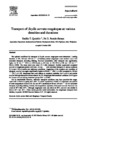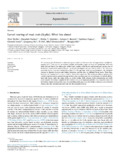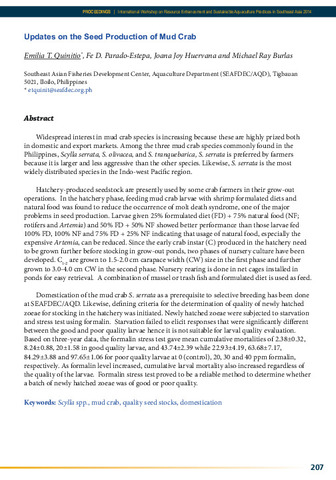Transport of Scylla serrata megalopae at various densities and durations

View/Open
Date
2000Page views
558Metadata
Show full item recordCited times in Scopus
43 readers on Mendeley
Share
Abstract
The optimal conditions for transport of Scylla serrata megalopae were determined. Loading densities of 50, 100 and 150 ind l−1 of hatchery-reared megalopae were studied over a 6-h simulated transport, including shaking. Survival immediately after transport was significantly higher at 50 ind l−1 (99.3±1.6%) (mean±x%) than at 100 (93.0±5.0) and 150 ind l−1 (94.0±3.8%). The same trend was noted 15 h after transport. Another experiment compared survival of megalopae packed at 50 and 100 ind l−1 with simulated transport of various durations (3, 6, and 9 h) at mobile and stationary conditions. Regardless of the duration and condition of transport, survival was again significantly higher at 50 ind l−1 (86.7±2.4%) compared to 100 ind l−1 (79.7±2.1%). Megalopae that were shaken or remained unshaken for 3 or 6 h had similar survival through transport as those shaken for 9 h. Megalopae that remained unshaken for 9 h gave the lowest survival among treatment groups (38.7±0.2%).
Due to cannibalistic behavior, stationary transport conditions may have provided the megalopae with a chance to grasp each other. In a third experiment, a batch of megalopae was packed at water temperature levels of 20, 24, and 28°C (ambient) at 50 and 100 ind l−1 for 6 h simulated transport, including shaking. Density and temperature separately influenced survival. Survival was lower at 28°C than 24°C. Although megalopae were less active at 20°C, survival was similar to that at 24°C and 28°C. These results provide useful information for megalopae transport from hatchery to ponds.
Suggested Citation
Quinito, E. T., & Parado-Estepa, F. D. (2000). Transport of Scylla serrata megalopae at various densities and durations. Aquaculture , 185(1-2), 63-71. https://doi.org/10.1016/S0044-8486(99)00334-8
Subject
Taxonomic term
Collections
- AQD Journal Articles [1248]
Related items
Showing items related by title, author, creator and subject.
-
Larval rearing of mud crab (Scylla): What lies ahead
Waiho, Khor; Fazhan, Hanafiah; Quinitio, Emilia T.; Baylon, Juliana C.; Fujaya, Yushinta; Azmie, Ghazali; Wu, Qingyang; Shi, Xi; Ikhwanuddin, Mhd; Ma, Hongyu (Elsevier, 2018)The increasing global demand for mud crabs (genus Scylla) and threats to the wild populations highlight the urgency of fully rearing them in captivity. Despite considerable progress in mud crab production, most crab farms ... -
Mud crab pond and pen culture
Rodriguez, Eduard M. (University of the Philippines Aquaculture Society, Inc, 2001) -
Updates on the seed production of mud crab
Quinitio, Emilia T.; Parado-Estepa, Fe D.; Huervana, Joana Joy; Burlas, Michael Ray (Aquaculture Department, Southeast Asian Fisheries Development Center, 2015)Widespread interest in mud crab species is increasing because these are highly prized both in domestic and export markets. Among the three mud crab species commonly found in the Philippines, Scylla serrata, S. olivacea, ...



